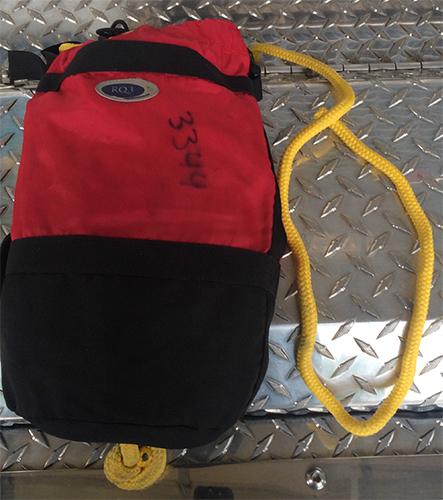Throw Back to Basics Training Drill | By Brian Zaitz

Almost every fire department has the potential to make a water rescue, whether it is from a river, a lake, or a creek that runs through the area or from the high waters of a storm that produces swift water conditions in relatively benign areas. The ability to rapidly respond and quickly instigate a rescue plan is essential to both the victim’s survival and the rescuer’s safety.
One of the easiest and relatively safest ways to accomplish this rescue is by the use of throw ropes. Everyone is familiar with the water rescue idea of “Reach, Throw, Row, Go” as an escalation of methods, with throwing being accomplished with little water rescue training at all. That being said, some routine and frequent training is essential to be proficient in throwing rope bags for success in rescue situations.

The rope bag or throw rope is found on almost every fire apparatus in America, it is a light bag that traditionally can hold 50 to 75 feet of nylon rope with some type of floatation device at the bottom of the bag. The bag and rope are designed to float, allowing for great visibility and enhancing the chance of the victim grabbing it.
 To deploy the rope bag, open it to allow the rope to disperse freely, then grab the rope in your nondominant hand, step on the end of the rope, and throw the bag in front of the victim. Make sure not to wrap your hand or wrist with the rope; you always want to be able to quickly let go of the rope if it becomes snagged. Ideally, the rope will fall, allowing the victim to grab the rope and either be pulled into the shore or ferry angled into shore; this essentially allows the current to push the victim into the shore while the rescue holds the rope. You should also train on recoiling the rope to provide a second throw for the victim if the first throw is not successful.
To deploy the rope bag, open it to allow the rope to disperse freely, then grab the rope in your nondominant hand, step on the end of the rope, and throw the bag in front of the victim. Make sure not to wrap your hand or wrist with the rope; you always want to be able to quickly let go of the rope if it becomes snagged. Ideally, the rope will fall, allowing the victim to grab the rope and either be pulled into the shore or ferry angled into shore; this essentially allows the current to push the victim into the shore while the rescue holds the rope. You should also train on recoiling the rope to provide a second throw for the victim if the first throw is not successful.
RELATED
- Training Minutes: Water Rescue: Throw Bags
- SWIFTWATER: Key to Command and Control at Water Rescues
- SWIFTWATER RESCUE TACTICS PART 1: LOW-RISK OPTIONS
You can accomplish this great training at almost every fire station. Go to an open area and throw your ropes with a “mock” victim. Have your crew don their personal floatation devices to add realism to the training.
Take the time today to practice with your throw ropes so that when the call comes in, you know your crew is ready to respond.
Download this training bulletin as a PDF HERE (4.5 MB)
Brian Zaitz  is a 15-year student of the fire service and the Captain-Training Officer with the Metro West Fire Protection District. Zaitz is also an instructor with Engine House Training, LLC , an instructor at the St. Louis County Fire Academy, and the Board of Director with the International Society of Fire Service Instructors. He has several degrees including an associates in paramedic technology, a bachelor’s in fire science management, and master’s in human resource development. Zaitz is also a credentialed chief training officer through the Center for Public Safety Excellence as well as a student of the National Fire Academy’s Executive Fire Officer Program.
is a 15-year student of the fire service and the Captain-Training Officer with the Metro West Fire Protection District. Zaitz is also an instructor with Engine House Training, LLC , an instructor at the St. Louis County Fire Academy, and the Board of Director with the International Society of Fire Service Instructors. He has several degrees including an associates in paramedic technology, a bachelor’s in fire science management, and master’s in human resource development. Zaitz is also a credentialed chief training officer through the Center for Public Safety Excellence as well as a student of the National Fire Academy’s Executive Fire Officer Program.
MORE THROW BACK TO BASICS

